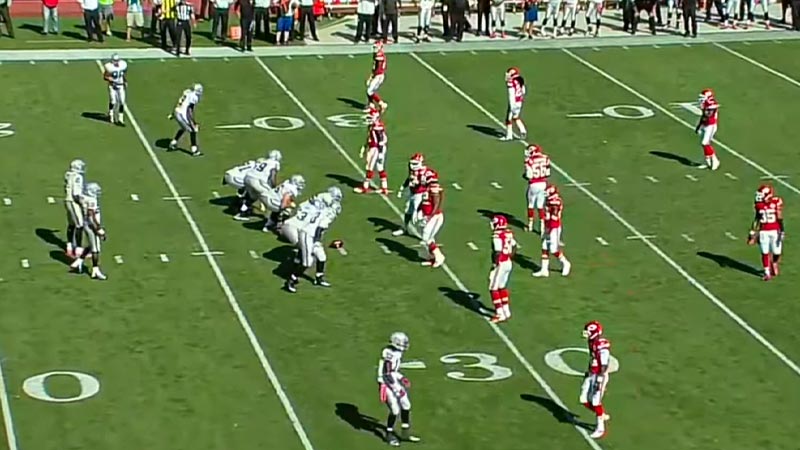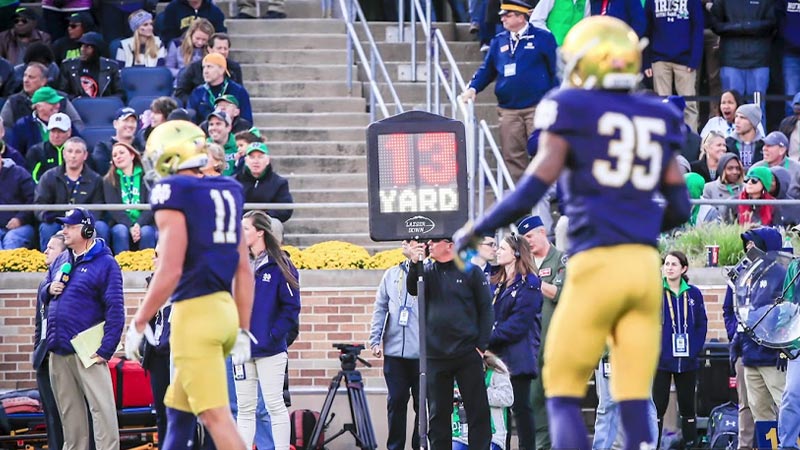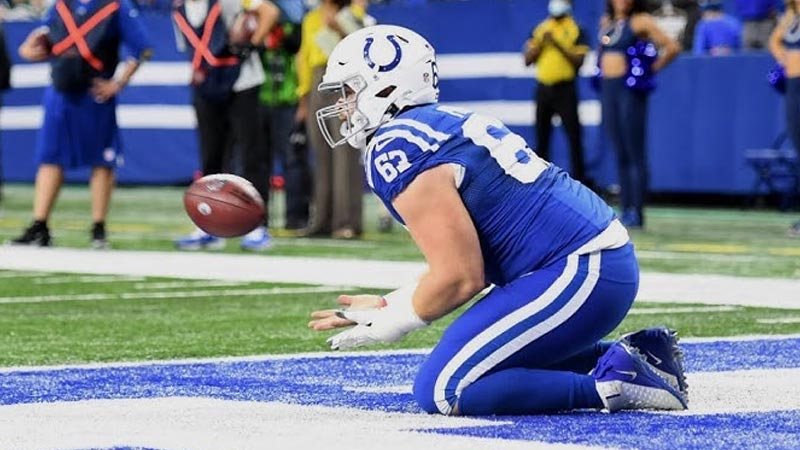American football is a game of strategy, athleticism, and intricate rules that make it a unique and captivating sport. One of the fundamental aspects that sets American football apart is the down rule.
Whether you’re a die-hard fan or just starting to explore the world of football, understanding the down rule is essential to grasp the flow of the game.
In this guide, we will dive into the intricacies of the down rule, breaking it down into simple terms and answering some of the most frequently asked questions.
What Is Football Down And Distance?
In American football, “down and distance” refers to the current play’s situation in terms of the number of attempts a team has to advance the ball (down) and the yards needed to achieve a new set of downs (distance).
American football is played in a series of plays called “downs,” with each team alternating between offense and defense.
Here’s how it works:
Down
A team has four attempts, or “downs,” to advance the ball at least 10 yards toward the opponent’s end zone. If they successfully gain those 10 yards, they are awarded a new set of four downs to continue their offensive drive.
Distance
The “distance” is the number of yards needed to achieve a new set of downs. It is always set at 10 yards. So, on a team’s first down, the distance is 10 yards. If they gain 4 yards on the first play, the next play would be a “2nd and 6” (second down and 6 yards to go).
The goal of the offensive team is to move the ball down the field by gaining at least 10 yards in four downs. They can do this through running plays or passing plays. If they fail to gain the required 10 yards in four downs, the opposing team gains possession of the ball from where it was last downed.
The down-and-distance situation can significantly influence a team’s strategy. For example, on a “3rd and long” situation (third down and a significant distance to go), teams are more likely to attempt a pass play since they need to cover a larger distance.
On the other hand, on a “4th and short” situation (fourth down and only a few yards to go), teams might opt to go for it and attempt to convert, rather than punting or attempting a field goal.
What Is Down Rule in Football?

The “down rule” in football refers to the number of attempts, or “downs,” that an offensive team has to advance the ball a certain distance toward the opponent’s end zone.
The primary purpose of the down rule is to ensure that both teams have a fair opportunity to move the ball down the field and score points.
In American football, each offensive possession begins with a first down. The offensive team has four downs to advance the ball at least 10 yards.
If they successfully gain those 10 yards within the four downs, they are awarded a new set of four downs, and the process continues. The distance needed to achieve a new set of downs is always 10 yards.
Here’s how the down rule works:
- The offensive team starts with a first down and 10 yards to go. They can choose to run or pass the ball to gain yardage.
- If the offensive team gains yardage on the first play, the next down is called the second down. The down marker is updated to show the new distance to gain a first down. For instance, if the offense gains 3 yards on the first play, the situation becomes “2nd and 7” (second down and 7 yards to go).
- If the offensive team gains more yardage on the second play, the next down is called the third down. The down marker is again updated with the new distance. For example, if the offense gains 4 yards on the second play, the situation becomes “3rd and 3” (third down and 3 yards to go).
- If the offensive team still hasn’t gained enough yardage to achieve a new set of downs after three plays, they face a fourth-down situation. They can choose to go for it, attempting to gain the necessary yardage to achieve a first down.
- They can choose to punt the ball to the opposing team, essentially giving up their offensive possession and trying to pin the opponent deep into their territory.
- They can attempt a field goal if they are close enough to the opponent’s end zone and believe they can successfully kick the ball through the goalposts.
The down rule plays a critical role in the strategy of the game, as teams must carefully consider their play calls based on the down and distance situation.
Down and Distance in NFL
In the NFL, “down and distance” is a fundamental concept dictating offensive strategies. It represents the number of attempts (downs) a team has to advance the ball and the yards needed for a new set of downs. A typical series begins with first down and 10 yards to gain.
After each play, if the offense gains yardage, the down advances, while the distance reflects the remaining yards. If they gain enough yardage within four downs, they receive another set.
For instance, “2nd and 5” means second down with 5 yards to gain. Teams tailor plays based on the situation; short yardage on early downs, riskier attempts on later downs. Understanding down and distance is pivotal, shaping the dynamic strategies that drive NFL games.
Four Downs After Offence Reaches the First Down

After the offense reaches the first down in the NFL, they are awarded a new set of four downs to continue their drive. Each down represents an opportunity for the offensive team to gain the necessary yardage for another first down or even score a touchdown.
Let’s delve into the progression of these downs and their significance:
1st Down
The offensive series starts with first down and 10 yards to go. The team can choose from a variety of plays to advance the ball down the field.
The primary objective is to gain enough yardage within these first three downs to achieve another first down and extend the drive.
2nd Down
If the offense gains yardage on the first play, they move on to second down. The distance required for a first down is adjusted based on the yardage gained.
For example, if the offense gains 5 yards on first down, it becomes “2nd and 5,” indicating they need 5 yards for a new set of downs. Teams often aim for manageable distances on second down to increase their chances of converting.
3rd Down
After the second down, if the offense hasn’t gained enough yardage for a new first down, they face a crucial third down. The play selection becomes strategic, as they must cover the remaining distance to secure another set of downs.
If it’s “3rd and long,” meaning a significant distance remains, teams might opt for passing plays, while “3rd and short” situations may lead to running plays.
4th Down
If the offense still hasn’t achieved a new first down after three downs, they reach fourth down. At this point, they face a pivotal decision. They can attempt to gain the necessary yardage to earn a fresh set of downs, often using their best plays.
Alternatively, they might opt to punt the ball to flip field position, try a field goal attempt, or even take a calculated risk and go for it, especially if they are close to converting.
In essence, the progression of downs after reaching the first down is a strategic chess match between the offensive and defensive teams. The offense aims to sustain their drive by gaining yardage, while the defense works to halt their progress and force a turnover.
The down system adds layers of strategy and excitement to football games as teams manage these opportunities to move the ball and control the flow of the game.
Types of Down and Distance in Football
Down and distance situations in football play a crucial role in shaping offensive strategies and play calling. Here are several types of down and distance scenarios commonly encountered in the game:
1st and 10
This is the starting point for most offensive possessions. The offense has the first of four attempts (downs) to cover a distance of 10 yards to achieve a new set of downs. Play options are open, often involving a balanced mix of run and pass plays to gain substantial yardage.
2nd and Short (e.g., 2nd and 4)
With just a few yards to go for a first down on the second attempt, offenses often opt for a variety of plays. This situation provides an opportunity for both run-and-pass plays, maintaining the element of surprise.
3rd and Medium (e.g., 3rd and 7)
As the third down approaches, the offense has a moderate distance to cover. Pass plays are more likely due to the necessity of gaining significant yardage. Defensive teams often prepare for possible passes, aiming to stop the advance.
4th and Medium (e.g., 4th and 6)
If an offense hasn’t gained enough yardage for a new set of downs within three attempts, they often face a decision. They can choose to go for it, punt the ball, or attempt a field goal. This distance might influence the decision to go for it rather than kick.
2nd and Goal
This scenario occurs when the offensive team is close to the opponent’s end zone. The exact yardage can vary greatly but typically falls within a few yards of the goal line. It’s a critical situation, with plays specifically tailored to score a touchdown.
3rd and Long (e.g., 3rd and 12)
With a significant distance to go on the third down, offenses often resort to passing plays. These situations are challenging, as the defense anticipates passes and aims to prevent first downs.
4th and Short (e.g., 4th and 1)
A pivotal moment when the offense has a short distance to go for a first down or touchdown. The decision to go for it, attempt a field goal, or punt can significantly impact the game’s outcome.
Each down-and-distance scenario requires strategic decision-making by coaches and players. Offensive and defensive strategies are tailored to these situations, showcasing the dynamic and tactical nature of football.
FAQs
What exactly is the down rule in American football?
The down rule in American football refers to the four opportunities or attempts a team has to advance the ball by at least 10 yards toward the opponent’s end zone.
Each attempt, known as a “down,” begins with the ball snapped from the line of scrimmage and ends when the ball is declared dead.
The offense aims to gain enough yards in these downs to earn a new set of downs and continue their progress toward the end zone.
What happens if a team doesn’t gain 10 yards in four downs?
If a team fails to advance the ball 10 yards within the allotted four downs, possession of the ball is turned over to the opposing team. This turnover is commonly referred to as a “change of downs.”
The new offensive team then starts their series of downs from the spot on the field where the previous team’s possession ended.
Are there any exceptions to the four-down rule?
In most levels of American football, including the professional NFL, teams have four downs to advance the ball 10 yards. However, some variations, like high school and college football, have rules that allow for more downs.
College football, for instance, provides teams with three downs instead of four. These differences can influence strategic decisions made by teams based on the number of downs available.
What strategic considerations come into play with the down rule?
The down rule plays a pivotal role in shaping a team’s strategic decisions. As the offense progresses through their series of downs, they must balance their play-calling between running and passing plays.
Short-yardage situations might call for running plays to gain a few yards, while longer distances might necessitate passing plays.
Teams often have to decide whether to risk attempting a long pass to gain significant yardage in one play or opt for shorter plays to increase their chances of converting the downs.
Can a team reset their downs during a play?
While a team cannot reset their downs during a single play, there are certain situations where they can earn a new set of downs without advancing the full 10 yards.
For instance, if the offensive team commits a penalty, and the result of that penalty includes a first down, the team’s downs are reset. This provides the team with another opportunity to advance the ball and continue their possession.
Wrapping Up
The down rule is the heartbeat of American football, driving the ebb and flow of the game. With only four opportunities to make meaningful progress, each down becomes a crucial juncture that demands strategic thinking, skilled execution, and split-second decision-making.
Whether you’re watching a game from the stands or the comfort of your home, understanding the down rule adds a new layer of appreciation for the tactics and intensity that make American football an iconic sport.
Hopefully, you have got the point. Thank you for your time.







